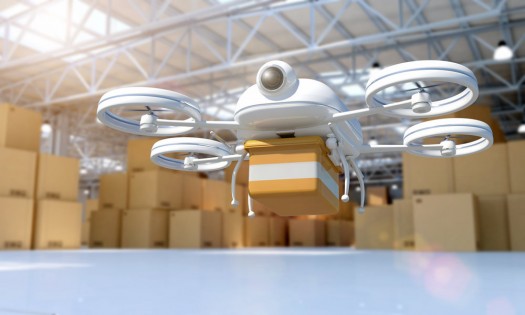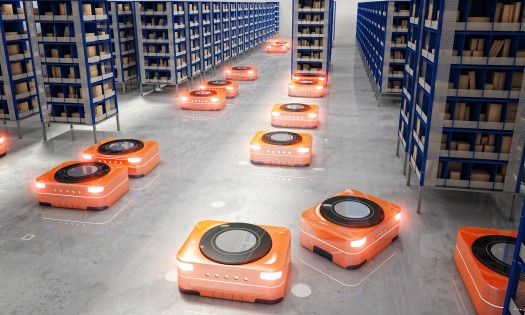Wasp Barcode Technologies: The Barcode Solution People
Not Just Delivery: The Future of Commercial Drones

Consumers hold certain expectations when it comes to their parcel delivery. They want it quickly, with as little fuss as possible, and with their order intact and undamaged. How quickly, though, is quick enough?
Shipping times dropped dramatically as new advents in technology came along through the years. Instead of months, packages could appear at your door in a matter of weeks once automobiles became the norm. Overnight airmail helped slash the timeframe into days. Now drones could turn those days into hours, perhaps even minutes.
[Tweet "Shipping times dropped dramatically as new advents in technology came along through the years."]
While the consumer drone market took a massive hit – some manufacturers found their prices reduced by as much as
70 per cent – the
commercial market remains strong. Now, manufacturers such as
DJI and
3DR look to help usher in this new era of commercialisation.
But don’t think delivery drones will appear in a wide-spread capacity in the near future. While the Civil Aviation Authority relaxed some of its drone regulations to help with Amazon’s
Cambridge tests, concerns and limitations remain abundant.

For these tests’ purposes, regulations with regards to operation of a drone without a direct line of sight and uses of anti-collision technology gained a little leeway. The CAA considered it a way to help foster a spirit of co-operation and forward thinking for the future of business.
That said, no hard and fast
regulations exist at this time that govern the commercial uses of drones,
especially for delivery purposes. Concerns remains over the current battery life spans of drones, as well as the accuracy of their GPS devices and unit security, both on the ground and in the air.
Airports in London and Liverpool reported four
near-misses between jetliners and drones in a single month in late 2016. The yearly total to that point stood at 56 incidents, almost double that of 2015’s entirety!
What of the viability of drone delivery? What exactly would companies deliver? What sort of range could consumers expect? Would delivery promises such as “
30 minutes or it's free” receive a second chance?
While no answers for these questions exist yet, Amazon’s
trial runs proved successful enough for the company to expand its R&D facilities. The Cambridge offices will grow to house approximately 400 employees to help foster the growth of
Amazon Prime Air. The two test runs in December 2016 gave hope that future deliveries could easily lead the way to a new level of consumer satisfaction.
Issues remain, of course: At this time, deliveries require you live near a distribution center. The flight ceiling sits at 122 metres (400 feet) with a maximum payload of 2.2 kilograms (5 pounds). A small bag of sugar or flour or perhaps a table lamp could make the trip but not a small bowling ball.
These flights can only take place during daylight hours with little-to-no wind. Even relaxed regulations are no match for the whimsy of Mother Nature. And yes, Amazon does expect to get your parcel to you within 30 minutes!
Delivery would only add to the industrial potential of drones. The Royal Mail service plans to join Amazon with its own drone delivery services, as does DHL.
[Tweet "Delivery would only add to the industrial potential of drones."]
As it stands now, several industries already consider them a valuable resource. In Drones Direct’s
2016 UK Drone Usage Report, the top five industries included:
- Media (63 per cent)
- Facility management (39 per cent)
- Oil and utilities (34 per cent)
- Agriculture (18 per cent)
- Construction (17 per cent)
Emergency service providers now include drones in search operation, for much the same reason that construction firms will perform inspections via drone. These machines can travel over areas humans beings cannot easily or safely reach and offer unexplored angles to observe.
[caption id="attachment_5990" align="aligncenter" width="525"]

automated warehouse 3d rendering image[/caption]
The UK isn’t alone in its drone stance:
PricewaterhouseCoopers established its own drone observation setting – a Drone Powered Solution, or DPS – in its native Poland. Poland’s UAV-friendly regulations make it easier to understand the potential in these vehicles.
As of December 2016, the DPS estimated the
current worldwide market value of drones at £100 billion. Infrastructure management contributed the greatest portion of this sum (£36 billion). The data provided by these machines can prove invaluable to maintenance of city roadways and bridges, but also offer great opportunities for survey and construction companies.
Imagine if, during your bid proposal, you could offer overhead footage of a recent job well-done. You could provide safety statistics that demonstrated how you could quickly and with greatly reduced hazard to humanity patrol your job site.
Imagine how well your potential employers would take the possibility of a job brought to closure under time
and under budget, and the reflection your company would cast.
Doesn’t it look nice?
 Consumers hold certain expectations when it comes to their parcel delivery. They want it quickly, with as little fuss as possible, and with their order intact and undamaged. How quickly, though, is quick enough?
Shipping times dropped dramatically as new advents in technology came along through the years. Instead of months, packages could appear at your door in a matter of weeks once automobiles became the norm. Overnight airmail helped slash the timeframe into days. Now drones could turn those days into hours, perhaps even minutes.
[Tweet "Shipping times dropped dramatically as new advents in technology came along through the years."]
While the consumer drone market took a massive hit – some manufacturers found their prices reduced by as much as
Consumers hold certain expectations when it comes to their parcel delivery. They want it quickly, with as little fuss as possible, and with their order intact and undamaged. How quickly, though, is quick enough?
Shipping times dropped dramatically as new advents in technology came along through the years. Instead of months, packages could appear at your door in a matter of weeks once automobiles became the norm. Overnight airmail helped slash the timeframe into days. Now drones could turn those days into hours, perhaps even minutes.
[Tweet "Shipping times dropped dramatically as new advents in technology came along through the years."]
While the consumer drone market took a massive hit – some manufacturers found their prices reduced by as much as  For these tests’ purposes, regulations with regards to operation of a drone without a direct line of sight and uses of anti-collision technology gained a little leeway. The CAA considered it a way to help foster a spirit of co-operation and forward thinking for the future of business.
That said, no hard and fast
For these tests’ purposes, regulations with regards to operation of a drone without a direct line of sight and uses of anti-collision technology gained a little leeway. The CAA considered it a way to help foster a spirit of co-operation and forward thinking for the future of business.
That said, no hard and fast  automated warehouse 3d rendering image[/caption]
The UK isn’t alone in its drone stance:
automated warehouse 3d rendering image[/caption]
The UK isn’t alone in its drone stance: 

